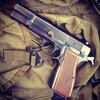Good morning everyone.
My first post, and I know nothing about guns, so I'm hoping that the good people here might give me a few pointers.
My new book follows a man in 1962 who requires a handgun made in Belgium. I didn't know, but it turns out Belgium makes a lot of guns. For a handy, easy to use gun, I thought perhaps the FN Model 1910 would be appropriate. What do you think?
Also, in the story, I need the gun to jam. Was that at all likely?
Any assistance gratefully appricated.
My first post, and I know nothing about guns, so I'm hoping that the good people here might give me a few pointers.
My new book follows a man in 1962 who requires a handgun made in Belgium. I didn't know, but it turns out Belgium makes a lot of guns. For a handy, easy to use gun, I thought perhaps the FN Model 1910 would be appropriate. What do you think?
Also, in the story, I need the gun to jam. Was that at all likely?
Any assistance gratefully appricated.







